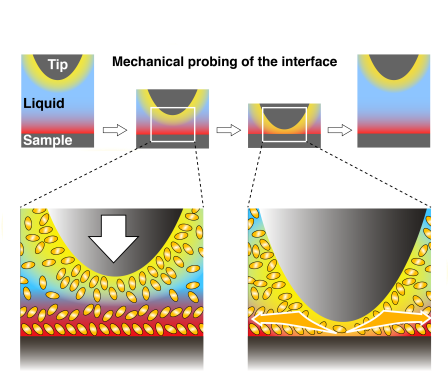Investigation techniques
Research interests:
Investigation techniques
Despite the ubiquitous importance of solid-liquid interfaces in science and technology, little is know about their structure and behaviour at the nanoscale, partly due to the experimental difficulty in gaining local insight on that scale.Experimental techniques capable of providing the highest resolution details about the interfaces (e.g. X-ray diffraction or spectroscopy) rely on spatial averaging, rendering the study of interfaces involving chemically inhomogeneous solids or nanoscale singularities particularly challenging. These limitations are particularly frustrating because most solids are irregular both chemically and structurally. Additionally, interfacial phenomena such as self-assembly or molecular/charge exchanges are often enhanced at interface singularities.Scanning probe approaches can in principle overcome these difficulties owing to their ability to probe interfaces locally, often with sub-nanometre resolution. Most our research relies on atomic force microscopy (AFM), a scanning probe technique capable of investigating almost any solid-liquid interface (provided the liquid is transparent to the microscope’s laser and the liquid not too viscous).
In recent work we showed that the energy dissipated by a vibrating AFM tip at the interface can be related to the local work of adhesion (or free solvation energy). The link between the two quantities is not obvious; it can be explained by lateral slippage of the liquid at the surface of the solid under the effect of the tip. This AFM-based approach provides a tool to simultaneously map the interfacial liquid with sub-nanometre precision and derive quantitative information about its local affinity for the solid.In all scanning probe measurements, the main challenge comes from the difficulty in disentangling contributions from the probe and from the interface studied. The presence of the probe at the interface may also artificially affect the results.

Comparison with computer simulations of a same system but without the AFM tip usually provides valuable complementary information about the “natural” system although still not on comparable timescales.Ultimately, it is desirable to have several techniques providing complementary information on a same system and collaborations are often the best way forward.One possibility is to combine AFM measurements with optical spectroscopies and florescence-based approaches. If successfully implemented, this approach makes it possible to obtain information about interfaces locally, globally and on different timescales simultaneously.
